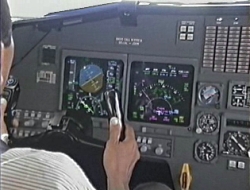All people on board are alive
The plane took off from CHAPECO, SC, BRAZIL [SBCH 27° 08' 02" S, 052° 39' 32" W] around 17:00 UTC [14:00 BRT] to a short flight for 13 minutes [70 Km = 37,8 NM] to land in ERECHIM, RS, BRAZIL [SSER 27° 39' 48" S, 052° 16' 19" W].
The Learjet 45 had its landing with tailwind above the tailwind limit recommendation of 10 Knots.
We can watch on video the windsock showing wind speed above 10 Knots and swinging in variable directions.
Runway length has 1280 meters.
AERODROME OBSTICLES
- OBS OBST (Antenna) DIST 2564 meters from THR 14, AZM 328 DEG,
HGT 280 ft;
- OBS OBST (Antenna) DIST 3434 meters from THR 14, AZM 002 DEG,
HGT 475 ft;
- OBS OBST (Antenna) DIST 3701 meters from THR 14, AZM 007 DEG,
HGT 408 ft;
- OBS OBST (Antenna) DIST 3059 meters from THR 14, AZM 016 DEG,
HGT 347 ft;
- OBS OBST (Antenna) DIST 1604 meters from THR 14, AZM 037 DEG,
HGT 182 ft;
Compulsory TFC Circuit by AD SECT SW
In
line with Federal Aviation Administration (FAA)
specifications, windsocks may be orange,
yellow, or white and may not have any logos
or lettering. The most useful windsocks for determining wind speed
are those with stripes of alternating colors,
such as orange and white, or lines at
set intervals.
The
red and white striped windsock is the most common version, but windsocks of
many different colors are used for specific applications where a colorful
windsock may not be suitable. Nature reserves tend to only allow green
windsocks to prevent color pollution, for example.
The
FAA has specific windsock specifications to ensure that you do not end
up incorrectly reading a makeshift windsock at a remote aerodrome.
The
FAA specifies that the windsock length must be either eight feet [243 cm]
with a throat diameter of 18 inches [46 cm] or a length of 12 feet [366 cm] with
a throat diameter of 36 inches [15 cm] . The fabric used must be water-repellant
and colorfast, as the windsock will be constantly exposed to the elements.
The
entire windsock assembly must be able to operate in a temperature range of -67
degrees Fahrenheit (-55 degrees Celsius) to 131 degrees Fahrenheit (55
degrees Celsius) and must be able to sustain wind speeds of up to 75
knots. [139 Km/h]
How
to Estimate Wind Speeds
Using
the stripes of a windsock, a reasonably accurate estimate of the wind speed can
be made.
Each
stripe of a windsock
represents 3 knots of wind. In other words, the windsock will orientate
itself with the wind direction and extend the first
stripe when the wind speed
reaches 3 knots. When the second stripe extends, the wind speed
is 6 knots, and so on, until all stripes are extended when
the wind speed is 15 knots or more.
I have been suggesting to pilots to keep on their minds interpreting windsock speed based on windsock angles [ 0 (zero), 45° and 90° ) as illustrated at the right.

















